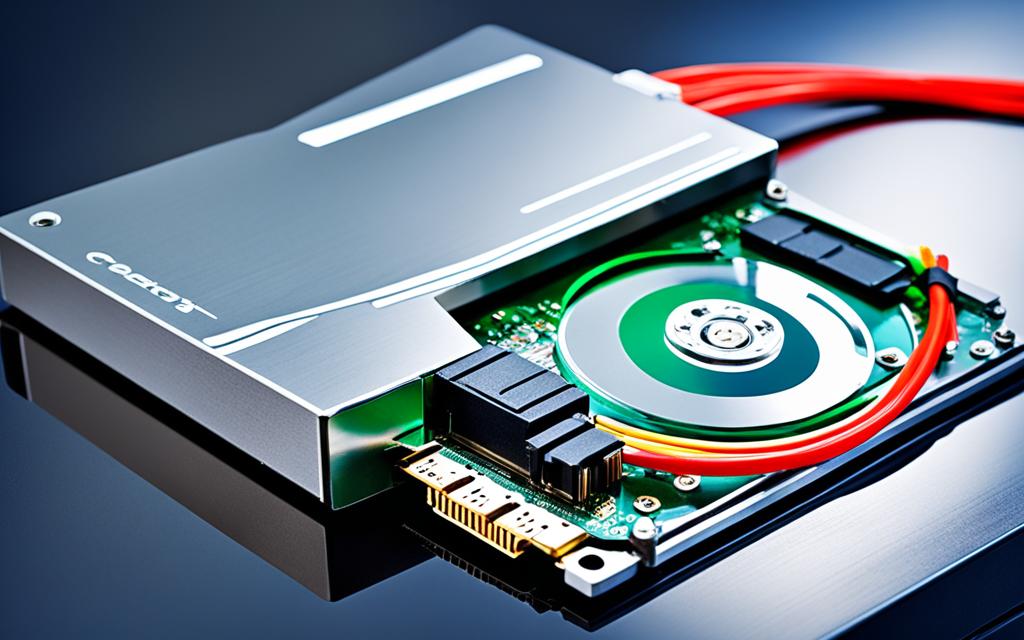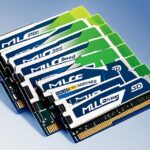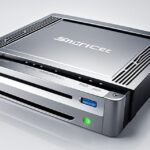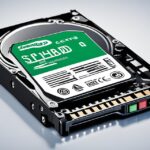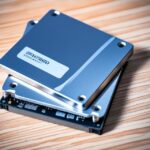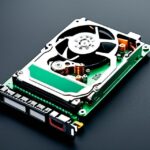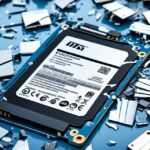Table of Contents
HDD SATA stands for Hard Disk Drive Serial Advanced Technology Attachment. It’s a crucial storage technology found in computers, laptops, and servers. This tech uses a SATA interface for smooth data moving between the hard drive and the motherboard. It’s the core of fast data access and connection for hard drives.
Even with SSDs becoming popular, HDD SATA is key for storing lots of data cheaply, especially in big enterprise settings. SATA drives are reliable, with a 3 to 4-year lifespan. This comes from a study by BackBlaze1 that looked at 25,000 hard drives. The SATA interface has gotten better over time, with upgrades boosting speed and performance while keeping costs down2.
Key Takeaways
- HDD SATA is a commonly used interface for hard disk drives.
- It offers dependable storage options from 500 GB to 16 TB.
- The typical lifespan of SATA hard drives is around 3 to 4 years.
- SATA interfaces have improved, reaching speeds of up to 6 Gb/s.
- Despite new storage technologies, HDD SATA drives are still cost-effective for big data needs.
Understanding HDD SATA Technology
HDD SATA technology has changed the way we use data storage in our computers. This system, called Serial Advanced Technology Attachment (SATA), makes connecting hard drives and SSDs more efficient.
Definition of HDD SATA
SATA means a way for computers and storage devices like hard disks and SSDs to talk to each other. The first version of SATA allowed for speeds of up to 1.5 Gbps. This was a big leap over the older PATA standard. Later versions, like SATA II and SATA III, increased speeds to 3 and 6 Gbps34. SATA made it easier to manage cables and improved air flow in computers by needing fewer cables.
History of SATA Interfaces
The SATA journey started in 2003, replacing the older PATA technology. It improved on PATA’s flaws by using slimmer cables, up to 39 inches long, which added flexibility4. SATA became better over the years, including features like hot swapping. This lets you swap storage units without turning the computer off, boosting convenience. SATA drives are critical for fast data storage in both private and business computing5.
What is HDD SATA?
HDD SATA drives are a big part of today’s computers. They are known for being reliable and effective. Just knowing the features of HDD SATA shows us why they’re still chosen over newer tech.
Key Features of HDD SATA Drives
HDD SATA’s features are why they’re so popular. They come in sizes of 3.5-inch for desktops and 2.5-inch for laptops. They offer lots of storage capacity, from 500 GB to 16 TB. This range fits many different needs.
The SATA interface began in the early 2000s. It allows top data transfer speeds of 600 MB/s with SATA III technology. This evolution in data connection is crucial. More details are found here6.
Advantages of Using HDD SATA
The advantages of HDD SATA drives are many. They are more budget-friendly than SSDs. This is because HDDs offer more storage for less money. This makes them perfect for users who need a lot of space without spending too much.
Also, SATA drives usually last 3 to 4 years. This reliability is great for various uses7. They work with many systems and devices. This makes them easy to use in different settings, appealing to both personal and business users.
| Drive Type | Storage Capacity | Data Transfer Speed | Life Span | Cost-effectiveness |
|---|---|---|---|---|
| HDD SATA | 500 GB – 16 TB | Up to 600 MB/s | 3 – 4 years | Low cost per GB |
| SSD SATA | Similar Range | Up to 600 MB/s | Around 10 years | Higher cost per GB |
This is why HDD SATA drives are crucial for many today. They offer the right mix of storage capacity, speed, and price. This place is key in the wide-ranging world of data storage solutions8.
Comparing HDD SATA with Other Storage Options
When talking about storage, HDD vs SSD comparison is often noted. It analyzes how HDD SATA drives compare with SSDs in speed and use.
HDD SATA vs SSD: A Performance Overview
HDD SATA and SSDs differ mainly in speed, toughness, and lifespan. SSDs have faster data speeds, reaching up to 3,500 MB/s for NVMe models, while HDDs are slower, with a max of 150 MB/s9.
SSDs can transfer a 20 GB movie in under 10 seconds. HDDs take much longer, over two minutes9. Nonetheless, for those needing lots of storage on a budget, HDDs are still a good option.
The Role of HDD SATA in Business and Enterprise
In business, HDD SATA holds key benefits. They’re chosen for their high storage capability, up to 4 TB, fitting for backup and big data use10.
Using less power than SSDs, they give businesses a cost-saving storage option. A mix of HDD’s storage and SSD’s speed can lead to better business operation.
Consumer Usage Scenarios for HDD SATA
Consumer HDD SATA use leans towards needing more space. Many choose HDD SATA for large media, games, or files backup. Speed isn’t always crucial.
With great lifespan and cost-effectiveness, HDD SATA is popular for those wanting to preserve their digital collections affordably11. Often, people use both HDD and SSD to meet their storage needs.
Technical Specifications of HDD SATA
The specs of HDD SATA drives matter a lot for how well they perform and fit with other tech. Knowing these details can help you make smart choices about where to store your information.
Data Transfer Rates and Capacities
HDD SATA drives boast impressive data transfer speeds, which depend on the SATA version. For example, SATA 3.0 can reach speeds up to 6 Gbit/s. This is about 600 MB/s, making file transfers fast and smooth12. When it comes to how much they can hold, these drives offer anything from 500 GB to a massive 16 TB. With so much space, HDD SATA drives are perfect for both personal use and big businesses13.
Connection and Compatibility Considerations
One key feature of HDD SATA tech is its compatibility. These drives match well with lots of motherboards and operating systems, serving a wide audience13. They’re also backwards compatible, meaning new drives can work in older systems but might run a bit slower. This lets you upgrade storage without having to replace your whole computer. Plus, technologies like Native Command Queuing (NCQ) make organizing data on these drives more efficient12.
Conclusion
HDD SATA drives might seem old-fashioned next to the quick progress of SSDs. Yet, they’re key in storing data. They’re affordable and can hold lots of data. Especially for businesses needing reliable, big storage, HDD SATA is vital.
Looking ahead, HDD SATA still has a bright future. Even as new tech comes in, these drives stay relevant. They last long and are good at data recovery. This makes them a solid option if things go wrong.
Remember, professional help can be crucial in saving your data on SATA drives. It ensures your important information stays secure.
HDD SATA’s value isn’t just about the past. It’s about fitting with changing storage needs too. It’s ideal for those with huge data or tight budgets. To understand these drives better, check this detailed guide here14.
FAQ
What is HDD SATA?
HDD SATA means Hard Disk Drive Serial Advanced Technology Attachment. It’s a storage device that connects to your computer’s motherboard using a serial interface. This allows for quick data access and transfer.
What are the main features of HDD SATA drives?
HDD SATA drives can hold a lot of data, from 500 GB up to 16 TB. They use a spinning method to access data. They’re more affordable than SSDs, making them a good choice for storing large amounts of data.
How does HDD SATA compare to SSDs?
SSDs are quicker and more reliable because they don’t have moving parts. However, HDD SATA drives offer more storage for less money. They are great for keeping large data amounts, like backups.
What is the historical significance of the SATA interface?
SATA came out in 2003, replacing the older PATA standard. It uses fewer wires, which helps with airflow in computer cases. It also supports hot swapping, letting you change drives without turning off the computer.
What are the data transfer rates of HDD SATA?
The speed of HDD SATA drives varies with the SATA interface version. SATA 3.0, for example, can reach speeds of up to 6 Gbit/s. This is a big improvement over older versions.
Are HDD SATA drives compatible with various systems?
Yes, HDD SATA drives work with most motherboards and operating systems. They can be used in both old and new technology, but they might run slower in older systems.
What roles do HDD SATA drives play in enterprise settings?
HDD SATA drives are key in businesses for storing a lot of data affordably. They are commonly used in servers and data centres. Their low cost makes them the top choice for companies that need a lot of storage.
Source Links
- https://www.cleverfiles.com/help/sata-hard-drive.html – What is a SATA hard drive? Definition & data recovery process
- https://www.pluralsight.com/blog/it-ops/types-of-hard-drives-sata-ssd-nvme – SSD Guide
- https://www.lenovo.com/us/en/glossary/sata/ – What is SATA? Explaining Data Storage Technology
- https://www.techtarget.com/searchstorage/definition/Serial-ATA – What is Serial ATA? An Introduction to SATA
- https://it.engr.ncsu.edu/help/kb/types-of-hard-drives/ – Types of Hard Drives – Engineering Information Technology Help
- https://www.ufsexplorer.com/articles/key-terms/sata-drive/ – What is a SATA drive? An Introduction to the interface
- https://www.gillware.com/hard-drive-data-recovery/what-is-a-sata-hard-drive/ – What is a SATA Hard Drive – Gillware Inc.
- https://www.stellarinfo.com/article/everything-about-sata-hard-drive.php – Everything You Need to Know About SATA Hard Drive
- https://www.avast.com/c-ssd-vs-hdd – SSD vs. HDD: Which Do You Need?
- https://www.freecodecamp.org/news/types-of-hard-drives-sata-pata-scsi-and-more-2/ – Types of Hard Drives – SATA, PATA, SCSI, and SSD
- https://abmfederal.com/a-comparison-between-data-storage-solutions-sata-vs-ssd-hdd/ – A Comparison Between Data Storage Solutions – SATA vs SSD & HDD
- https://en.wikipedia.org/wiki/SATA – SATA
- https://www.delkin.com/blog/sata-serial-ata/ – SATA (Serial ATA) Technical Guide | Delkin Devices
- https://www.datarecovery.net/articles/what-is-sata-hard-drive.aspx – What is a SATA Hard Drive? Everything You Need to Know | ACE Data Recovery Services Article

